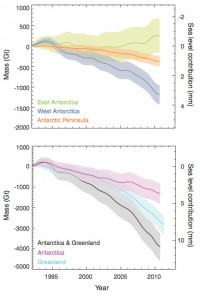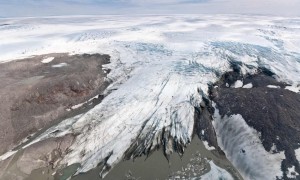From an Article by Damian Carrington, The Guardian (UK), March 11, 2020
Losses of ice from Greenland and Antarctica are tracking the worst-case climate scenario, scientists warn. The polar ice caps are melting six times faster than in the 1990s, according to the most complete analysis to date.
The ice loss from Greenland and Antarctica is tracking the worst-case climate warming scenario set out by the Intergovernmental Panel on Climate Change (IPCC), scientists say. Without rapid cuts to carbon emissions the analysis indicates there could be a rise in sea levels that would leave 400 million people exposed to coastal flooding each year by the end of the century.
Rising sea levels are the one of the most damaging long-term impacts of the climate crisis, and the contribution of Greenland and Antarctica is accelerating. The new analysis updates and combines recent studies of the ice masses and predicts that 2019 will prove to have been a record-breaking year when the most recent data is processed.
The previous peak year for Greenland and Antarctic ice melting was 2010, after a natural climate cycle led to a run of very hot summers. But the Arctic heatwave of 2019 means it is nearly certain that more ice was lost last year.
The average annual loss of ice from Greenland and Antarctica in the 2010s was 475bn tonnes – six times greater than the 81bn tonnes a year lost in the 1990s. In total the two ice caps lost 6.4tn tonnes of ice from 1992 to 2017, with melting in Greenland responsible for 60% of that figure.
The IPCC’s most recent mid-range prediction for global sea level rise in 2100 is 53cm. But the new analysis suggests that if current trends continue the oceans will rise by an additional 17cm.
“Every centimetre of sea level rise leads to coastal flooding and coastal erosion, disrupting people’s lives around the planet,” said Prof Andrew Shepherd, of the University of Leeds. He said the extra 17cm would mean the number of exposed to coastal flooding each year rising from 360 million to 400 million. “These are not unlikely events with small impacts,” he said. “They are already under way and will be devastating for coastal communities.”
Almost all the ice loss from Antarctica and half of that from Greenland arose from warming oceans melting the glaciers that flow from the ice caps. This causes glacial flow to speed up, dumping more icebergs into the ocean. The remainder of Greenland’s ice losses are caused by hotter air temperatures that melt the surface of the ice sheet.
The combined analysis was carried out by a team of 89 scientists from 50 international organisations, who combined the findings of 26 ice surveys. It included data from 11 satellite missions that tracked the ice sheets’ changing volume, speed of flow and mass.
About a third of the total sea level rise now comes from Greenland and Antarctic ice loss. Just under half comes from the thermal expansion of warming ocean water and a fifth from other smaller glaciers. But the latter sources are not accelerating, unlike in Greenland and Antarctica.
Shepherd said the ice caps had been slow to respond to human-caused global heating. Greenland and especially Antarctica were quite stable at the start of the 1990s despite decades of a warming climate.
The IPCC is in the process of producing a new global climate report and its lead author, Prof Guðfinna Aðalgeirsdóttir, of the University of Iceland, said: “The reconciled estimate of Greenland and Antarctic ice loss is timely.”
She said she also saw increased losses from Iceland’s ice caps last year. “Summer 2019 was very warm in this region.”




{ 1 comment… read it below or add one }
Something strange is happening to Greenland’s ice sheet — What should be like a snowcone is becoming more like a popsicle, speeding up the runoff from the melting ice sheet.
National Geographic Magazine, September 18, 2019
When the remnants of Europe’s second summertime heat wave migrated over Greenland in late July, more than half of the ice sheet’s surface started melting for the first time since 2012. A study published Wednesday in Nature shows that mega-melts like that one, which are being amplified by climate change, aren’t just causing Greenland to shed billions of tons of ice. They’re causing the remaining ice to become denser.
“Ice slabs”—solid planks of ice that can span hundreds of square miles and grow to be 50 feet thick—are spreading across the porous, air pocket-filled surface of the Greenland ice sheet as it melts and refreezes more often. From 2001 to 2014, the slabs expanded in area by about 25,000 square miles, forming an impermeable barrier the size of West Virginia that prevents meltwater from trickling down through the ice. Instead, the meltwater becomes runoff that flows overland, eventually making its way out to sea.
As the ice slabs continue to spread, the study’s authors predict more and more of Greenland’s surface will become a “runoff zone,” boosting the ice sheet’s contribution to global sea level rise and, perhaps, causing unexpected changes.
“We’re watching an ice sheet rapidly transform its state in front of our eyes, which is terrifying,” says lead study author Mike MacFerrin, a glaciologist at the University of Colorado, Boulder.
Watch a 4-Mile-Wide Iceberg Break From Greenland Glacier
A 4-mile-wide iceberg broke off the Helheim Glacier in Greenland in 2018, tumbling into the fjord below. The 35-minute calving was captured in this time-lapse video.
A ‘turtle shell’ for ice
It’s easy to think of Greenland as a solid, impenetrable hunk of ice. But in reality about 80 percent of the ice sheet’s surface is like a snowcone: A dusting of fresh snowfall covers a thick layer of old snow, called firn, that’s slowly being compressed into glacier ice but still contains plenty of air pockets. When the top of this snow cone melts in the summer, liquid water percolates down into the firn, which soaks it up like a 100-foot-thick sponge.
MacFerrin and his colleagues got their first hint that the firn may be losing its absorbency in the spring of 2012, when they were drilling boreholes through the firn in southwest Greenland. They started finding dense, compacted layers of ice in core after core, just below the seasonal snow layer. It was, MacFerrin says, as if a “turtle shell” had formed over the firn.
MacFerrin and his colleagues immediately wondered whether that shell might be preventing meltwater from percolating into the firn.
“That was May of 2012,” MacFerrin says. “And July was this record-breaking melt year, and we got our answer very quickly.”
That summer, for the first time on record, meltwater from this part of Greenland visibly started to flow away as runoff.
Realizing they had witnessed something significant, the researchers set about drilling more cores over a larger region to see how extensive the ice shell was. They discovered that it spanned a transect 25 miles long and was having widespread effects on local hydrology.
Those findings, published in 2016 in Nature Climate Change, were the springboard for the new study. Using radar data from NASA’s IceBridge airborne campaign, as well as ground-based surveys, MacFerrin and his colleagues have now created a first-of-its-kind map of ice slabs across the entire surface of Greenland.
Based on modelling results, the researchers think the shell began to form and spread widely in the early 2000s. As of 2014, it covered some 4 percent of Greenland’s surface, according to the new analysis. Every summer that extensive melting occurs, it gets thicker and spreads inland to colder, higher ground.
“Every handful of years, these big melt summers are doing a number on the firn,” MacFerrin says. “That’s causing this whole process to grow inland pretty quickly.”
This photo is a segment of a firn core, essentially a baby ice slab that eventually will grow into a meters-thick slab of ice.
Ice slabs have already caused Greenland’s runoff zone to expand by about 26 percent, according to the new study. So far the additional runoff has only added about a millimeter to global sea levels. Greenland now contributes a little under a millimeter per year to rising sea levels, through a combination of icebergs breaking off glaciers and melt occurring at the surface and base of the ice sheet.
But if Greenland’s surface hardens more, runoff could rise dramatically. Under a worst-case scenario where carbon emissions continue to climb until the end of the century, the researchers calculated that ice slab proliferation could add up to 3 inches of sea level rise by 2100, boosting the ice sheet’s overall sea level rise contribution by nearly a third. In both a middle-of-the-road scenario where emissions peak by mid-century and the high emissions one, the amount of runoff from Greenland’s interior roughly doubles by century’s end.
But more runoff is only one potential consequence of the transformation taking place in Greenland’s ice. Kristin Poinar, a glaciologist at the University of Buffalo who wasn’t involved in the study, pointed out that slabs of solid ice aren’t nearly as reflective as bright white snowfall.
“And so, if we start getting these ice slabs forming near the ice sheet’s surface, it could potentially…cause the ice sheet to absorb more solar radiation and warm up,” she says. “And that would create more ice slabs.”
And runoff from ice slabs doesn’t have to flow into the ocean, said Indrani Das, a glaciologist at Columbia University who wasn’t involved in the study. She worries about how it could seep into the large crevasses that exist at lower elevations on the ice sheet. From there, the runoff could, potentially, flow all the way down to bedrock, lubricating the zone where the ice makes contact with it.
“That could make the ice sheet flow faster,” Das says, which could cause glaciers to spill their contents into the ocean more quickly, like ice cream sliding off a piece of cake.
To Poinar, the most significant contribution of the new study is that it will allow scientists to improve their projections of future sea level rise, giving coastal communities the information they need to prepare. At the same time, the study highlights the fact that the more carbon we spew into the atmosphere, the more we’re likely to transform Earth’s northern ice sheet in insidious and unexpected ways. And that could have consequences that are difficult to anticipate.
“We have never observed an ice sheet behaving this way before,” Poinar says. “It’s unprecedented in human scientific history.”
https://www.nationalgeographic.com/environment/2019/09/greenland-ice-getting-denser-thats-bad/